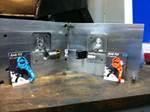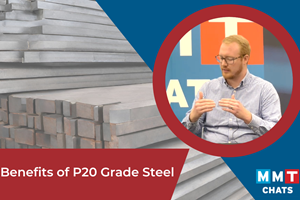Applying the Right Alloy
A focus on mold operating temperature and welding effects will help determine the right aluminum alloy for future mold builds.
Use of aluminum tooling has been an ongoing discussion for years, and the resulting flow of information has been a key part of aluminum’s growth as a mold material alternative. This continuous growth has led to advances in mold alloys, material size availability, mold design, finishing practices, coatings and welding techniques. More and more success stories involving aluminum tooling are being shared, and this is essential in helping to ensure that future programs are designed and implemented with aluminum in mind.
Most articles discussing the successes of aluminum tooling have been focused on 7xxx series aluminum alloys. Although these alloys have outstanding properties applicable to certain molding applications, they are not always the most appropriate choice.
Today there are a range of aluminum alloys available, and each has been used successfully for tooling in almost every industry, including automotive, medical, aerospace and consumer goods. Characteristics influencing alloy choice include the material’s dimensional stability, part geometry, mold operating temperature and welding effects. This article will focus on the mold operating temperature and welding characteristics of a few alloy series.
Mold Operating Temperature
Although many molds are not exposed to higher temperatures, heat’s effect on a mold must be examined. If a mold (or a section of a mold) needs to handle temperatures ranging from 300°F to 400°F, then yield strength at room temperature may not be a deciding factor when choosing an alloy. Keep in mind that the following figures are typical and approximate, as variances may be seen among different materials.
A 7xxx series alloy may have yield strength of 51,000-71,000 psi at ambient temperature (75°F), but at 300°F this strength is reduced by approximately 63 percent. At 400°F it is reduced by about 82 percent. Using the same examination for a 6061 alloy, yield strength is 40,000 psi at ambient temperature. At 300°F this strength is reduced by approximately 22 percent, and at 400°F it is reduced by about 62 percent.
Compare 2xxx series cast mold plate at these temperatures. Yield strength may only be 20,000 psi at ambient temperature, but at 300°F this strength is reduced by 22 percent. At 400°F it is reduced by 45 percent. Additionally, the cast 2xxx series will be more resistant to thermal fatigue because it is not heat-treated like 6061 and 7xxx series mold alloys. The properties of cast mold plate materials are derived from the alloy composition, not from a heat-treating process. These same alloy-driven properties also apply to 5xxx series cast plate material, which is often used for prototype molds.
When the 2xxx and 5xxx series cast mold plate returns to ambient temperature, it will have maintained its original properties. After exposure to higher temperatures, the heat-treated alloys will not return to their original strength, however. For example, the properties of the 7xxx series alloys at ambient temperature may drop down by as much as 50 percent after exposure to a 400°F temperature.
Welding Effects
On welded aluminum molds, the area around the weld displays three surface appearances: the parent material, filler wire and the heat-affected area due to welding. New techniques and filler wires help to minimize the heat effect on the material from welding, but applying that welding heat to a heat-treated material will cause a loss of metal strength in the welded area. Several aluminum mills have developed welding filler wire that works better with specialized 7xxx series mold alloys, providing improved color match and reduced porosity in the welded area. There also have been advances in welding 7xxx series aluminum, such as a DC pulse welding technique that minimizes heat in the welded area, improving part production after the repair.
Cast mold plate alloys in the 2xxx and 5xxx series also have specialized welding practices that contribute to successful aluminum mold repair. These include welding techniques that incorporate specialized filler wires, shielding gas and DC pulse procedures. As an additional benefit, these alloy families do not have the same issues with heat-affected zones as heat-treated 7xxx alloys. Since their properties come from the base alloy composition, the parent block and filler wire are the only two areas in the block affected by welding. The area around the weld is not affected, as it would be with 6061 and 7xxx series mold alloys. This ability to maintain strength after welding shows how 2xxx and 5xxx cast mold plate alloys offer increased resistance to thermal fatigue compared with heat-treated alloys.
Summary
Aluminum injection molds are capable of producing more than
1 million parts, making aluminum a viable mold material option for some applications. The design, production and processing of aluminum molds varies from that of steel, so it is critical to examine all of the material characteristics and application factors when considering an aluminum tool build.
Related Content
Specialist Automotive Mold Builder Mentors in Work and Life Skills
Southeastern mold builder PFAFF Molds sets the standard in toolmaking for automotive window and vehicle body sealing systems through knowledge-sharing and automation.
Read MoreMold Innovations Power Unique Auto Lighting Elements on Hummer EVs
Diamond machining, electroforming of micro-optical inserts and modified latch-lock system help injection molds produce unique forward lighting elements.
Read MoreHot Runner Technologies Advance Quality Surface Requirements in Automotive
Oerlikon HRSflow hot runner systems combine cost-efficient production with a precise process control for a variety of automotive applications.
Read MoreProject Reveals Added Benefits of New P20 Grade Steel in Machinability, Cycle Time and No Stress Relief
MoldMaking Technology's Christina Fuges talks with General Motors' Shane Appel about a project testing a new P20 steel grade's dimensional stability.
Read MoreRead Next
Optimizing Aluminum Tools
Plating aluminum molds for longer production life.
Read MoreReconsidering Aluminum
One mold maker sheds light on the advantages of this material from a machining and handling standpoint. Another argues that it can indeed be a viable alternative to tool steel beyond just prototyping and short-run applications.
Read MoreHow to Use Continuing Education to Remain Competitive in Moldmaking
Continued training helps moldmakers make tooling decisions and properly use the latest cutting tool to efficiently machine high-quality molds.
Read More

















.jpg;maxWidth=300;quality=90)







